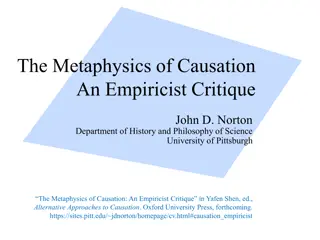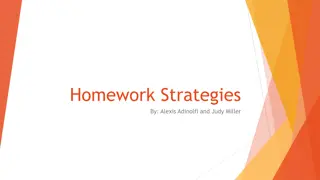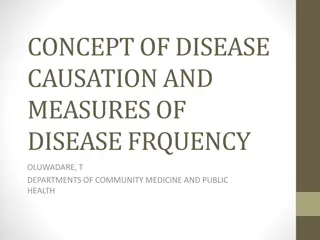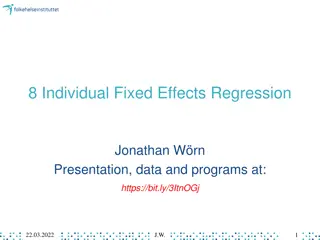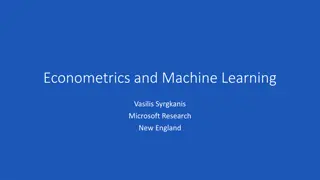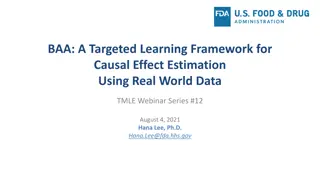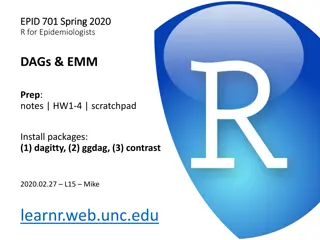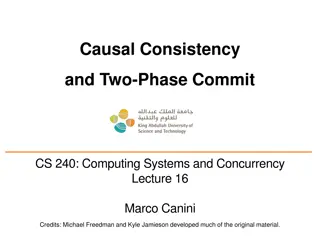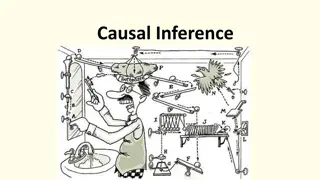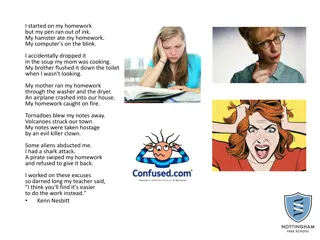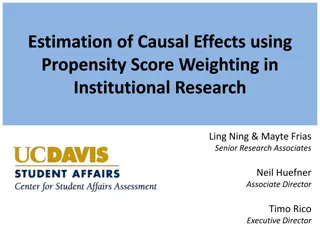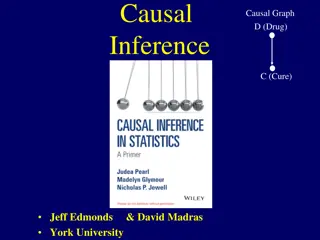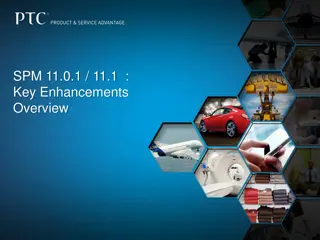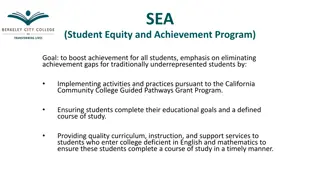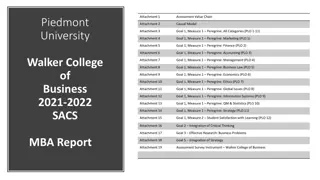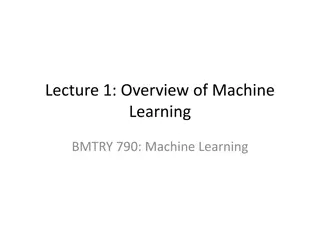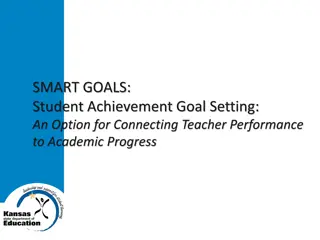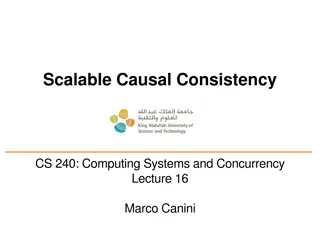Optimizing Homework Effect on Student Achievement Through Causal Machine Learning
Using TIMSS 2019 data from Ireland, a study conducted at Maynooth University explores the impact of homework frequency, duration, and question types on student achievement in math and science. By leveraging causal machine learning techniques, researchers aim to provide insights for educators on effective homework strategies to enhance student outcomes.
Download Presentation

Please find below an Image/Link to download the presentation.
The content on the website is provided AS IS for your information and personal use only. It may not be sold, licensed, or shared on other websites without obtaining consent from the author.If you encounter any issues during the download, it is possible that the publisher has removed the file from their server.
You are allowed to download the files provided on this website for personal or commercial use, subject to the condition that they are used lawfully. All files are the property of their respective owners.
The content on the website is provided AS IS for your information and personal use only. It may not be sold, licensed, or shared on other websites without obtaining consent from the author.
E N D
Presentation Transcript
Can we optimise the effect of homework on student achievement? Ann O Shea Maynooth University IMTA Conference 24 February 2024
Introduction to this Study Students experience of doing mathematics is usually through classroom tasks or through homework. Nathan McJames (a current PhD student in Maynooth University), Andrew Parnell and I have been using causal machine learning to investigate the effect of frequency and duration of homework on student achievement. We have also looked at the effects of the types of questions asked by teachers on students achievement.
Introduction to this Study We are using TIMSS 2019 data from Ireland. We have used machine learning techniques to try to answer questions like: How often should you give homework? How long should homework take? Is there a difference between Maths and Science homeworks? What kind of questions should you get students to work on?
Plan for Today What is TIMSS? What is Causal Machine Learning? What can we say about homework (frequency and duration)? What can we say about the types of questions asked? What do the results of our study mean for teachers?
What is TIMSS? The Trends in International Mathematics and Science Study (TIMSS) is an international large scale assessment which has taken place in many countries across the world every four years since 1995. There were 64 participating countries in 2019, including Ireland. Students in the fourth and the eighth grade (fourth class of primary school and second year of secondary school in Ireland) are given a short assessment in mathematics and science to estimate their achievement level in these subjects.
TIMSS Cognitive Domains in Mathematics As well as overall student achievement in mathematics, TIMSS evaluates student performance in the three cognitive domains of knowing, reasoning, and applying. Knowing: reflects a student s ability to recall and recognise facts as necessary when working on a mathematics problem. Reasoning: analyse, evaluate, and draw conclusions from mathematical situations, providing mathematical arguments to justify decisions. Applying: successfully apply mathematical facts, rules, and procedures to both real life and purely mathematical problems.
TIMSS 2019 Data Second year students also complete a short questionnaire on aspects such as confidence in mathematics, how many books and educational resources they have at home, the highest level of education received by their parents, and many more. The subset of the data from 2019, which we will focus on in this study, provides a representative sample of 4118 second year students, 51.2% of whom are male, with an overall average age of 14.4 years.
TIMSS 2019 Data Additionally, the mathematics teachers, science teachers, and school principals of these students complete a short questionnaire on teaching practices, years experience, and other school related factors. So for each student, there is information on a Personal level Classroom level School level Our aim is to control for all of this data, and isolate the effect of homework on achievement.
What is Causal Inference? Causal inference is the term used for the process of determining whether an observed association truly reflects a cause-and- effect relationship. We can ask questions such as: Does X cause Y? What is the effect of changing the values of X on the values of Y? But we need to be careful
Correlation does not imply Causation We can see that the sales of ice cream and the number of shark attacks are highly correlated. We don t believe that one causes the other. There is a confounding variable namely the weather.
What is Causal Machine Learning? Leveraging machine learning models to estimate causal effects, instead of just predicting an outcome. Machine learning models are very good at discovering complicated relationships hidden in data. They can also account for many different predictor variables. This is exactly what we need to tackle the problem of confounding! Nathan uses a method called Bayesian Causal Forests, based on Bayesian Additive Regression Trees.
What is Causal Machine Learning? We assume that there are two potential outcomes for each individual i, one that would be observed under treatment, ?? 1 , and one that would be observed under control, ??(0) (no treatment). The individual treatment effect would then be given by the difference between these potential outcomes: ??= ??1 ??0 . Observing individual i simultaneously under both treatment and control is impossible, however, and this is known as the fundamental problem of causal inference. Can estimate treatment effects with BART by predicting the two potential outcomes for each individual, using their observed characteristics and an indicator of whether or not they received treatment as predictor variables.
Nathans Project Study factors which impact on student achievement in TIMSS 2019 in Ireland. We are controlling for a wide variety of covariates (more than 40) including socioeconomic status, access to educational resources, parent education levels, teacher qualification, school specific factors, and many others
Homework Frequency and Duration in Maths and Science In TIMSS 2019 students were asked: How often does your teacher give you homework in (Subject)? Possible answers: Every Day; 3 or 4 times a week; 1 or 2 times a week; Less than once a week; Never. AND When your teacher gives you homework in (Subject), about how many minutes do you usually spend on your homework? Possible answers: I never get homework in (Subject); 1-15 minutes; 16-30 minutes; 31-60 minutes; 61-90 minutes; more than 90 minutes.
Reported Frequency and Duration Frequency Never < once per week 1 or 2 times per week 5.3% 3 or 4 times per week 25.7% Every day Maths 1.0% 1.0% 66.9% Science 4.2% 16.0% 38.7% 25.3% 15.8% Duration 1-15 minutes 16-30 minutes 31-60 minutes 61-90 minutes More than 90 minutes Maths Science 34.8% 40.0% 43.6% 41.0% 16.7% 12.3% 2.5% 1.5% 1.4% 1.0%
Effect of frequency (relative to getting homework twice per week or less)
For Mathematics, the optimal frequency to assign homework seems to be every day. On average, we expect that increasing the frequency from twice per week or less to everyday will increase student achievement in Maths by 7.36 points on the TIMSS scale. For Science, the optimal frequency to assign homework seems to be 3/4 times per week. On average, we expect that increasing the frequency to 3/4 times per week will increase student achievement in Science by 5.49 points on the TIMSS scale.
Effect of duration (relative to spending 15 minutes or less on homework)
Relative to receiving up to 15 minutes of homework, there is no significant benefit to increasing the duration to 15-30 minutes or to more than 30 minutes in Maths. There is some evidence that increasing Science homework duration to more than 30 minutes has a positive effect (Average treatment effect is 3.55 points).
Socioeconomic background does not influence effect of homework
The effect of different question types Studies have shown that: I. the types of tasks assigned to students can affect their learning; II. the use of tasks with lower levels of cognitive demand leads to rote-learning by students and a consequent inability to solve unfamiliar problems or to transfer knowledge to other areas competently and appropriately.
TIMSS Data on Classroom Activities How often do you do the following in teaching this class? 1. Ask students to complete challenging exercises that require them to go beyond the instruction. 2. Ask students to decide their own problem solving procedures. 3. Ask students to practice procedures on their own. The possible responses to these questions were: 1. Every or almost every lesson 2. About half the lessons 3. Some lessons 4. Never
TIMSS 2019 Mathematics Teacher Responses from Ireland How often do you do the following in teaching this class? Never Some Lessons Half the Lessons Every lesson Ask students to complete challenging exercises that require them to go beyond the instruction. Ask students to decide their own problem solving procedures. Ask students to practice procedures on their own. 3.2% 5.4% 0.3% 33.1% 40.3% 7.4% 38.5% 35.3% 20.2% 25.2% 19.0% 72.1%
Effect of asking students to work on challenging tasks in Maths classrooms
Effect of asking students to decide on their own problem solving strategies in Maths classrooms
Effect of asking students to practice procedures in Maths classrooms
The Effect of Classroom Tasks Relative to never, or only sometimes assigning challenging questions there is a clear positive effect of assigning questions of this type in about half of the lessons. This positive effect is increased when the frequency of assigning the challenging questions becomes every or almost every lesson. A similar pattern can be seen for the estimated effects of regularly asking students to decide their own problem solving procedure. In contrast, asking students to practice procedures on their own in about half or about every class has a negative effect on student achievement. The effect sizes are remarkably similar across all three cognitive domains.
Causal Analysis Summary We have seen that regular homework seems to be important for Maths and Science achievement. There are some differences in optimal frequencies for the two subjects. It looks like short assignments are as beneficial as longer ones. The types of tasks that students work on in class are important.
What is your experience? How often do you assign homework in Maths? How long would the homework take? If you teach Science too, is there a difference in how you assign homework in the two subjects? What kinds of tasks do you assign in class? Do you agree with the results presented here?


